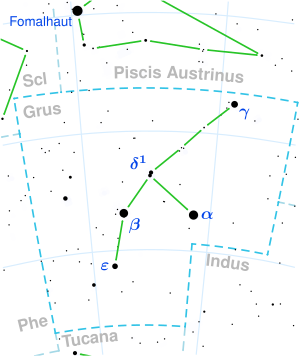Gliese 832
Location of Gliese 832 in the constellation Grus | |
| Observation data Epoch J2000.0 Equinox J2000.0 | |
|---|---|
| Constellation | Grus |
| Right ascension | 21h 33m 33.97512s[1] |
| Declination | −49° 00′ 32.3994″[1] |
| Apparent magnitude (V) | 8.66[2] |
| Characteristics | |
| Evolutionary stage | main-sequence star
|
| Spectral type | M2V[3] |
| B−V color index | 1.52[2] |
| Absolute magnitude (MV) | 10.19[2] |
| Details | |
Gyr | |
| Database references | |
Exoplanet Archive | data |
| Data sources: | |
Hipparcos Catalogue ,HD | |
Gliese 832 (Gl 832 or GJ 832) is a
This star achieved
Gliese 832 emits X-rays.[10] Despite the strong flare activity, Gliese 832 is producing on average less ionizing radiation than the Sun. Only at extremely short radiation wavelengths (<50nm) does its radiation intensity rise above the level of quiet Sun, but does not reach levels typical for active Sun.[11]
Planetary system
Gliese 832 hosts one known planet, with a second planet having been refuted in 2022.[6]
| Companion (in order from star) |
Mass | Semimajor axis (AU) |
Orbital period (years) |
Eccentricity | Inclination | Radius |
|---|---|---|---|---|---|---|
| b | 0.8+0.12 −0.11 MJ |
3.53+0.15 −0.16 |
9.88+0.34 −0.33 |
0.069+0.026 −0.027 |
54.9+6.6 −4.9 or 125.1+4.9 −6.6° |
— |
Gliese 832 b
In September 2008, it was announced that a
Gliese 832 c
Gliese 832 c was believed to be of super-Earth mass.[8] It was announced to orbit in the optimistic habitable zone but outside the conservative habitable zone of its parent star.[14] The planet Gliese 832 c was believed to be in, or very close to, the right distance from its sun to allow liquid water to exist on its surface.[8] However, doubts were raised about the existence of planet c by a 2015 study, which found that its orbital period is close to the stellar rotation period.[3] The existence of the planet was refuted in 2022, when a study found that the radial velocity signal shows characteristics of a signal originating from stellar activity, and not from a planet.[6]
The region between Gliese 832 b and where Gliese 832 c would be is a zone where additional planets are possible.[15]
Search for cometary disc
If this system has a comet disc, it is not "brighter than the fractional dust luminosity 10−5" according to a 2012 Herschel study.[16]
See also
- List of nearest stars
- List of extrasolar planets
Notes
- ^ Using the absolute visual magnitude of Gliese 832 and the absolute visual magnitude of the Sun , the visual luminosity can be calculated by
References
- ^ S2CID 244398875. Gaia DR3 record for this source at VizieR.
- ^ a b c d e f
Bailey, J.; Butler, R. P.; Tinney, C. G.; Jones, H. R. A.; O'Toole, S.; Carter, B. D.; Marcy, G. W. (2009). "A Jupiter-like Planet Orbiting the Nearby M Dwarf GJ832". S2CID 17172233.
- ^ S2CID 119181646.
- ^ S2CID 235435757. 40.
- S2CID 119216828.
- ^ S2CID 249674385.
- ^ "Gliese 832". SIMBAD. Centre de données astronomiques de Strasbourg. Retrieved 2018-09-23.
- ^ a b c d "Nearby Alien Planet May Be Capable of Supporting Life", Mike Wall, Space.com, June 25, 2014, http://www.space.com/26357-exoplanet-habitable-zone-gliese-832c.html
- S2CID 59039482, A35.
- ^
Schmitt, J. H. M. M.; Fleming, T. A.; Giampapa, M. S. (1995). "The X-ray view of the low-mass stars in the solar neighborhood". doi:10.1086/176149.
- S2CID 119279568.
- ^ S2CID 257663647.
- S2CID 119288366.
- ^
Wittenmyer, R.A.; Tuomi, M.; Butler, R.P.; Jones, H. R. A.; O'Anglada-Escude, G.; Horner, J.; Tinney, C.G.; Marshall, J.P.; Carter, B.D.; et al. (2014). "GJ 832c: A super-earth in the habitable zone". The Astrophysical Journal. 1406 (2): 5587. S2CID 12157837.
- S2CID 118663957
- ^
B. C. Matthews; forthcoming study promised in Lestrade, J.-F.; Matthews, B. C.; Sibthorpe, B.; Kennedy, G. M.; Wyatt, M. C.; Bryden, G.; Greaves, J. S.; Thilliez, E.; Moro-Martín, A.; Booth, M.; Dent, W. R. F.; Duchêne, G.; Harvey, P. M.; Horner, J.; Kalas, P.; Kavelaars, J. J.; Phillips, N. M.; Rodriguez, D. R.; Su, K. Y. L.; Wilner, D. J. (2012). "A DEBRIS Disk Around The Planet Hosting M-star GJ581 Spatially Resolved with Herschel". S2CID 53704989.




